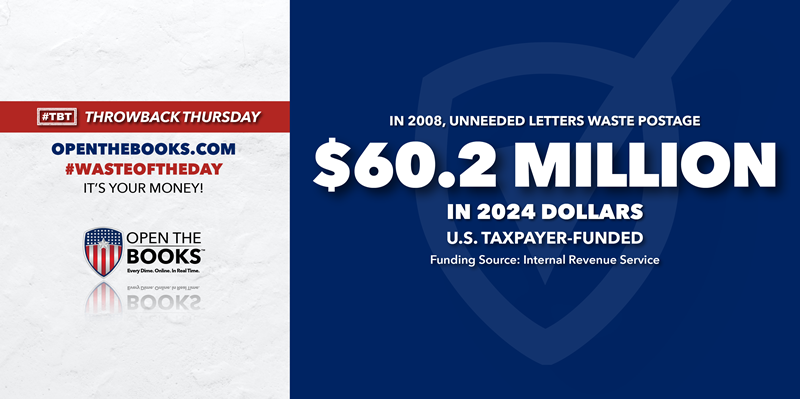
Denver Cuts Budgets $5 Million to Give Migrants Free Housing
March 4, 2024

Topline: The City of Denver announced $5 million in budget cuts to help pay for free shelter for migrants from the southern border, with more budget cuts expected.
But according to records at OpenTheBooks.com, roughly one-third of Denver city employees made six-figure salaries last year — raising the question of why city services that benefit taxpayers are the first to lose funding.
Key facts: Mayor Mike Johnston said on Feb. 9 that Department of Motor Vehicle offices will be closed for a week at a time on a rotating basis. The parks department will also see reduced funding, with recreation centers open for fewer hours and summer programming reduced by 25%.
With the border crisis worsening, Denver is projected to spend $180 million to shelter migrants this year, meaning additional budget cuts are sure to come.
If the city is worried about overspending, perhaps its $1.2 billion payroll should be the first fund account on the chopping block.
OpenTheBooks auditors found doctors making $373,000 and police officers making $281,000. Nearly 5,000 Denver employees took home more than $100,000 in 2023.
Then, the city paid $225 million into its employees’ retirement plans — Denver’s second-largest expenditure in 2023.
Background: Denver spent $42 million to house 38,830 migrants in the last year. There are 3,813 people currently in shelters.
Texas Gov. Greg Abbott contributed to that total by offering migrants free bus rides to Denver, as well as Chicago or New York — all Democratic cities that Abbott says need to “understand what is going on” at the border. Denver has been a popular option and is now trying to bus those same migrants to New York and other areas.
Johnston blamed House Republicans for failing to pass a bill in February that would have accelerated asylum claims and work permits for migrants in Denver, lessening the need for free housing.
Johnston suggested that the GOP is intentionally avoiding solving the border crisis so that former President Donald Trump can campaign on the issue and boost his chances of winning the presidential election.s
Critical quote: “Residents of Denver should be heartbroken and they should be furious,” Johnston said in a video posted on Instagram. “All that we asked is for the federal government to do the very minimum of their part to help alleviate this crisis … [Trump] intervened with House leadership to kill the bill just so this crisis would continue.”
Summary: The City of Denver certainly could have found $5 million in its massive payroll rather than take money from important government departments to aid migrants. And that’s aside from the debate over whether Denver should be spending money to give immigrants free housing in the first place.
NIH Awards $200,000 Grant for Transgender Voice Training
March 5, 2024

Topline: The National Institutes of Health is paying $214,000 for three researchers to create a “transgender voice training” app, according to Fox News.
Key facts: The study aims to address “voice dysphoria,” which researchers say causes lower quality of life when a person’s voice does not match their gender identity.
Researchers will coach 40 trans women to help change the pitch and resonance of their voice to sound more feminine.
The participants will meet once a week with a speech-language pathologist. Half of them will use a generic voice training software and half will use the app specifically made for transgender people, so that results can be compared.
If tests are successful, the software will be released to the public for free.
The researchers — a professor from the University of Cincinnati and two speech scientists from New York University — have each already received taxpayer money for similar voice dysphoria studies, according to the College Fix.
Background: The study focuses on “gender-affirming voice and communication training,” a service that is already dipping into taxpayers’ wallets. As of 2022, 13 states’ Medicaid covered the training, with 18 more having no clear policy on the coverage.
The 2024 research grant comes from the National Institute on Deafness and Other Communication Disorders, an agency of the National Institutes of Health.
The NIH is part of the Department of Health and Human Services, which sent paychecks to almost 90,000 people in 2022, according to auditors at OpenTheBooks.com.
There were 2,646 employees who earned more than $214,000, the grant amount for the voice training app.
Supporting quote: "Some trans people can be negatively impacted if their voice is perceived as incongruous with their gender identity, and they may choose to work with a speech pathologist to achieve a vocal presentation that is comfortable for them," said Tara McAllister, one of the three study leaders.
"The staRt software allows learners to visualize the resonant frequencies of the vocal tract, which could make it easier to adjust them to match a target that is appropriate for their personal speech goals."
Summary: Three researchers are getting an additional $214,000 the federal government to study gender-affirming voice therapy — from an agency that’s supposed to focus on deafness and other communication disorders — on top of past funding they’ve already received.
Pentagon Has No Clear Plan For $1.8 Billion AI Budget
March 6, 2024

Topline: The Department of Defense doesn’t know how it will use artificial intelligence in its daily operations, despite receiving $1.8 billion for that purpose in this year’s budget.
Key facts: The Pentagon has invested billions of dollars since 2018 to explore how to use AI for tasks traditionally completed by humans. AI could potentially operate deadly weapons, analyze surveillance data, increase business efficiency and more.
But according to a report from the U.S. Government Accountability Office, the DOD still “can’t fully identify” exactly how it plans to use AI now or in the future. There is currently no way for the DoD to know which human positions can or will be replaced with AI or estimate how much additional funding is needed.
That means the DoD may not meet its goal of being AI-ready by 2025, and billions of taxpayer dollars will have been inefficiently spent.
The Pentagon has been issuing written plans to its workers explaining how AI will be integrated into the workforce. But some of the documents do not even directly reference AI, according to the GAO.
The written plans are also inconsistent in their wording. For example, one plan uses the term “critical technology” to reference AI, while another uses “digital talent,” and so on. The GAO says, “this could prevent a common department-wide understanding of AI workforce strategic goals and objectives.”
Background: Last June, the GAO reported that the Pentagon did not have department-wide guidance on what kinds of AI software should be developed and purchased.
That led to a slow procurement process that hurt AI goals overall; by the time new technologies were acquired, they were already outdated.
However, spending continues to increase. China has been spending a much greater percentage of its military budget on AI research, leaving defense experts concerned that America will fall behind.
Critical quote: Alexandr Wang — the CEO of Scale AI, a private firm that creates technology for the Pentagon — spoke about inefficient AI spending in a recent House of Representatives hearing.
“AI systems are only as good as the data that they are trained on,” Wang said. “The DoD creates more than 22 terabytes of data daily, and because of their outdated data retention and management policies, warfighters, analysts, and operators are unable to tap into its full potential because it is not AI-ready.”
Summary: With the U.S. accounting for 40% of the world’s defense spending, our military should reflect the world’s latest technological advancements. Poor financial planning at the Pentagon seems to be impeding that plan.
Throwback Thursday: IRS Wastes $42 Million On Postage
March 7, 2024

Throwback Thursday!
Topline: In 2008, Congress sent stimulus checks to most Americans to try and avoid the impending recession. The move made news around the country — but apparently not enough that the IRS felt satisfied.
The government spent $42 million to send letters informing Americans that their stimulus check would arrive soon in a separate letter, costing $60.2 million in 2024 dollars.
That’s according to the “Wastebook” reporting published by the late U.S. Senator Dr. Tom Coburn. For years, these reports shined a white-hot spotlight on federal frauds and taxpayer abuses.
Coburn, a U.S. Senator from Oklahoma, earned the nickname "Dr. No" by stopping thousands of pork-barrel projects using the Senate rules. Projects that he couldn't stop, Coburn included in his oversight reports.
Coburn's Wastebook 2008 included 65 examples of outrageous spending worth more than $1.3 billion, including the $42 million postage expense from the IRS.
Key facts: President George W. Bush signed the Economic Stimulus Act in February 2008, sending payments of up to $600 to almost everyone in America.
The IRS — gentlemen that they are — did each taxpayer the personal courtesy of sending a letter to let them know their stimulus check was on the way.
The notice gave taxpayers the vital information that they did “not have to do anything” to receive their stimulus check as long as they had a Social Security number.
The only real purpose of the letter would have been to warn those who did not file a 2007 tax return that they could miss out on the stimulus check, but an additional letter was sent to members of that group.
Critical quote: “There are countless better uses for $42 million than a self-congratulatory mailer that gives the president a pat on the back for an idea that wasn’t even his,” Sen. Chuck Schumer (D-NY) told the Associated Press at the time.
Coburn, who voted against the stimulus bill, added that "If 10,000 Oklahomans call the White House today and said this is stupid, fix it, we might get something happening."
Supporting quote: IRS Spokesperson David Stell offered this defense of the letters: "That's a decision that was made in our Washington office based upon the best minds that were there to think about the best way to inform the public about this."
Summary: The wait for an exciting piece of mail can indeed be agonizing. But not at the cost of $42 million of taxpayer money.
Maryland School Spent $4 Million to Figure Out How to Use Grant Money
March 8, 2024

Topline: Schools in Maryland have been using grant funding to hire consultants to teach them how to use the grant funding, according to a new report from the state Inspector General.
Key facts: Maryland has sent $649 million in grants to schools in impoverished communities since 2019.
But the state provided little to no direction on how to use the grant money, the IG told WBAL-TV 11 Baltimore.
Maryland’s director of community schools is supposed to provide instructions, but that position was vacant for six months last year. School districts ended up calling a dead phone line for help. Even when the position was filled, school leaders said they received poor advice.
With no direction from the state, schools used grant money to hire private firms that could teach them how to spend their funds. One school signed a five-year, $4.1 million contract for such a purpose. The total amount spent on consultants is unknown.
These costs were reported to state officials, who failed to flag them or raise any concerns.
Maryland prepared instructional PowerPoints and videos for grant recipients, but there is no evidence these materials were actually shared with schools, the IG found. Maryland instead provided “ambiguous” verbal guidance with “little to no written approval.”
There has been little oversight on spending. The first grant audit began in September 2023 and has yet to be completed.
Background: The grants were part of the 2021 Blueprint for Maryland’s Future, one of the most ambitious education initiatives in recent history.
The Blueprint aims to boost education spending by $3.8 billion every year for 10 years, with a large portion going toward pay raises for teachers.
The plan uses state and local money, but counties are already struggling to contribute their portion of funds.
But if counties are worried about funding, perhaps they should address salaries at Baltimore County Community College.
OpenTheBooks recently found that BCCC President Debra L. McCurdy has been paid $1.5 million since 2019.
McCurdy earned $593,000 in 2022 including incentives. That’s almost as much as President Joe Biden and the mayor of Baltimore combined.
Summary: Schools are supposed to be spending grant funds to educate their students, not their own staff.
The #WasteOfTheDay is presented by the forensic auditors at OpenTheBooks.com.